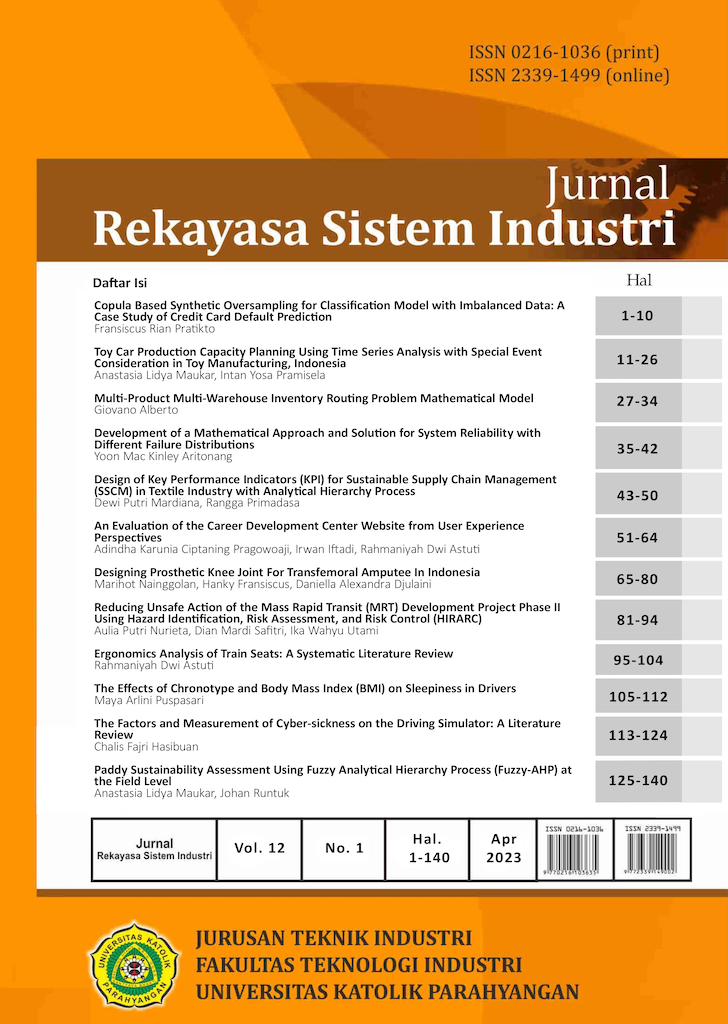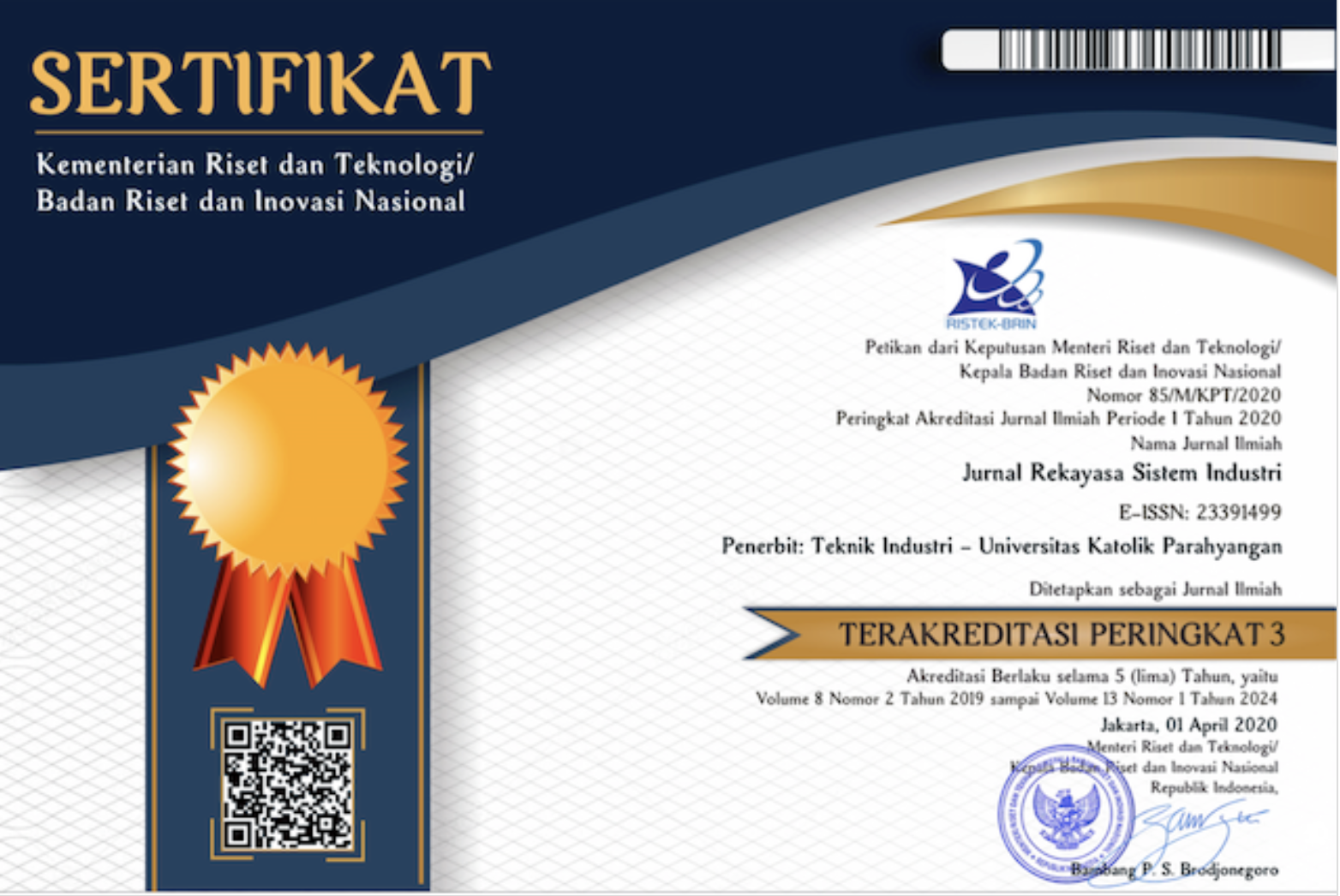Faktor-Faktor Dan Pengukuran Cybersickness Pada Driving Simulator: Tinjauan Pustaka
DOI:
https://doi.org/10.26593/jrsi.v12i1.6547.113-124Kata Kunci:
simulator mengemudi, cybersickness, faktor, pengukuran, tinjauan literaturAbstrak
Simulator mengemudi merupakan salah satu alat penelitian yang digunakan untuk mengidentifikasi penyebab kecelakaan lalu lintas di jalan raya. Simulator mengemudi sering digunakan di bidang penelitian, terdapat kekhawatiran bahwa simulator mengemudi berbasis HMD dapat menyebabkan efek samping bagi pengguna yang dikenal sebagai cybersickness. Berbagai faktor banyak digunakan untuk mengidentifikasi terbentuknya cybersickness dari berbagai virtual environment dengan memberikan hasil yang berbeda-beda terhadap cybersickness yang terbentuk sedangkan secara khusus faktor yang mempengaruhi terhadap terbentuknya cybersickness menggunakan simulator mengemudi menggunakan virtual reality berbasis HMD belum diidentifikasi apakah menghasilkan hasil penelitian yang sama atau berbeda, sehingga dapat memberikan perbedaan yang terhadap penelitian selanjutnya. Tujuan penelitian ini melakukan literature review terhadap faktor yang digunakan untuk mengidentifikasi cybersickness yang tebentuk pada penggunaan simulator mengemudi menggunakan virtual reality berbasis HMD dan hasil dari penggunaan faktor tersebut. Metode yang digunakan dengan penelusuran artikel dari data base antara lain google scholar, science direct, scopus, springer dan IEEE dengan kata kunci yang relevan. Dalam pencarian awal, istilah 'VR sickness', 'cybersickness', 'motion sickness', 'simulator sickness', 'visually induced motion sickness', 'virtual reality', dan 'simulator mengemudi', eliminasi menggunakan metode PRISMA. Dari 653 artikel yang diperoleh menghasilkan 17 artikel yang dianalisis lebih lanjut terkait simulator mengemudi menggunakan virtual reality berbasis HMD. Hasil menemukan faktor yang mempengaruhi cybersickness yang terbentuk seperti jenis kelamin, umur pengguna, pengalaman, postur pengguna, lamanya penggunaan, perangkat keras yang digunakan, Field Of View (FOV), penyakit bawaan serta waktu penggunaan. Dari 17 artikel yang dianalisis tidak ada perbedaan hasil dari faktor yang digunakan untuk mengidentifikasi cybersickness yang terbentuk.
Referensi
Agić, A., & Mandić, L. (2019). Evaluation of cybersickness in virtual reality in simulator mengemudi. In Acta Graphica (Vol. 30, Issue 2).
Arafat, I. M., Ferdous, S. M. S., & Quarles, J. (2016). The effects of cybersickness on persons with multiple sclerosis. Proceedings of the ACM Symposium on Virtual Reality Software and Technology, VRST, 02-04-November-2016, 51–59. https://doi.org/10.1145/2993369.2993383
Bahit, M., Wibirama, S., Nugroho, H. A., Winadi, M. N., & Wijayanto, T. (2016). Pengaruh Kebugaran Fisik dan Perbedaan Waktu Pagi-Malam pada Cybersicknes Saat Memainkan Video Game Simulasi Mengemudi.
Benzeroual, K., & Allison, R. S. (2013). Cyber (motion) sickness in active stereoscopic 3D gaming. 2013 International Conference on 3D Imaging, 1–7. https://doi.org/10.1109/IC3D.2013.6732090
Bonato, F., Bubka, A., Palmisano, S., Phillip, D., & Moreno, G. (2008). Vection change exacerbates simulator sickness in virtual environments. Presence: Teleoperators and Virtual Environments, 17(3), 283–292. https://doi.org/10.1162/pres.17.3.283
Brooks, J. O., Goodenough, R. R., Crisler, M. C., Klein, N. D., Alley, R. L., Koon, B. L., Logan, W. C., Ogle, J. H., Tyrrell, R. A., & Wills, R. F. (2010). Simulator sickness during driving simulation studies. Accident Analysis and Prevention, 42(3), 788–796. https://doi.org/10.1016/j.aap.2009.04.013
Chang, E., Hwang, I., Jeon, H., Chun, Y., Kim, H. T., & Park, C. (2013). Effects of rest frames on cybersickness and oscillatory brain activity. 2013 International Winter Workshop on Brain-Computer Interface (BCI), 62–64. https://doi.org/10.1109/IWW-BCI.2013.6506631
Chang, E., Kim, H. T., & Yoo, B. (2020). Virtual Reality Sickness: A Review of Causes and Measurements. International Journal of Human-Computer Interaction, 1658– 1682. https://doi.org/10.1080/10447318.2020.1778351
Chardonnet, J.-R., Mirzaei, M. A., & Mérienne, F. (2015). Visually Induced Motion Sickness Estimation and Prediction in Virtual Reality using Frequency Components Analysis of Postural Sway Signal Frédéric Merienne Ecole Nationale Supérieure d’Arts et Métiers Visually Induced Motion Sickness Estimation and Prediction in Virtual Reality using Frequency Components Analysis of Postural Sway Signal. https://www.researchgate.net/publication/283856134
Chen, Y.-C., Dong, X., Hagstrom, J., & Stoffregen, T. A. (2011). Control of a virtual ambulation influences body movement and motion sickness. BIO Web of Conferences, 1, 00016. https://doi.org/10.1051/bioconf/20110100016
Dennison, M. S., Wisti, A. Z., & D’Zmura, M. (2016). Use of physiological signals to predict cybersickness. Displays, 44, 42–52. https://doi.org/10.1016/j.displa.2016.07.002
Dong, X., Yoshida, K., & Stoffregen, T. A. (2011). Control of a virtual vehicle influences postural activity and motion sickness. Journal of Experimental Psychology: Applied, 17(2), 128–138. https://doi.org/10.1037/a0024097
Dong, X., & Stoffregen, T. A. (2010). Postural activity and motion sickness among drivers and passengers in a console video game. Proceedings of the Human Factors and Ergonomics Society, 2, 1340–1344. https://doi.org/10.1518/107118110X12829369835680
Dobie, T., McBride, D., Dobie Jr., T., May, J., 2001. The effects of age and sex on susceptibility to motion sickness. Aviat. Space Environ. Med. 72, 13–20.
Freitag, S., Weyers, B., & Kuhlen, T. W. (2016). Examining Rotation Gain in CAVElike Virtual Environments. IEEE Transactions on Visualization and Computer Graphics, 22(4), 1462–1471. https://doi.org/10.1109/TVCG.2016.2518298
Gálvez-García, G., Hay, M., & Gabaude, C. (2015). Alleviating simulator sickness with galvanic cutaneous stimulation. Human Factors, 57(4), 649–657. https://doi.org/10.1177/0018720814554948
Gonçalves, G. (2018). Virtual Reality Games: a study about the level of interactionvs.narrative and the gender in presence and cybersickness. IEEE
Goodge, T., Kroll, V., Vernon, M., Ventsislavova, P., & Crundall, D. (2021). A comparison of cybersickness symptoms across 360-degree hazard perception and hazard prediction tests for drivers. Applied Ergonomics, 97. https://doi.org/10.1016/j.apergo.2021.103549
Golding, J. F. (2006). Motion sickness susceptibility. Autonomic Neuroscience: Basic and Clinical, 129(1–2), 67–76. https://doi.org/10.1016/j.autneu.2006.07.019
Häkkinen, J., Ohta, F., & Kawai, T. (2019). Time course of sickness symptoms with HMD viewing of 360-degree videos. IS and T International Symposium on Electronic Imaging Science and Technology, 2019(3). https://doi.org/10.2352/J.ImagingSci.Technol.2018.62.6.060403
Howarth, P. A., & Costello, P. J. (1997). The occurrence of virtual simulation sickness symptoms when an HMD was used as a personal viewing system
Hildebrandt, J., Schmitz, P., Calero Valdez, A., Kobbelt, L., & Ziefle, M. (2018). Get Well Soon! Human Factors’ Influence on Cybersickness after Redirected Walking Exposure in Virtual Reality
Jaeger, B. K., & Mourant, R. R. (2001). Comparison of Simulator Sickness Using Static and Dynamic Walking Simulators. Proceedings of the Human Factors and Ergonomics Society Annual Meeting, 45(27), 1896–1900. https://doi.org/10.1177/154193120104502709
J. Edquist, T. Horberry, S. Hosking, and I. Johnston, “Effects of advertising billboards during simulated driving,” Appl. Ergon., vol. 42, no. 4, pp. 619– 626, May 2011
Jeng, J., Lin, W., Duh, H. B. L., Parker, D. E., Abi-Rached, H., & Furness, T. A. (2002). Effects of Field of View on Presence, Enjoyment, Memory, and Simulator Sickness in a Virtual Environment.
Kim, J., Chung, C. Y. L., Nakamura, S., Palmisano, S., & Khuu, S. K. (2015). The Oculus Rift: A cost-effective tool for studying visual-vestibular interactions in selfmotion perception. Frontiers in Psychology, 6(MAR). https://doi.org/10.3389/fpsyg.2015.00248
Kim, K., Rosenthal, M. Z., Zielinski, D. J., & Brady, R. (2014). Effects of virtual environment platforms on emotional responses. Computer Methods and Programs in Biomedicine, 113(3), 882–893. https://doi.org/10.1016/j.cmpb.2013.12.024
Keshavarz, B., Hecht, H., & Zschutschke, L. (2011). Intra-visual conflict in visually induced motion sickness. Displays, 32(4), 181–188. https://doi.org/10.1016/j.displa.2011.05.009
Keshavarz, B., Ramkhalawansingh, R., Haycock, B., Shahab, S., Campos, J.L., 2018. Comparing simulator sickness in younger and older adults during simulated driving under different multisensory conditions. Transport. Res. F Traffic Psychol. Behav. 54, 47–62.
Kennedy, R. S., Lane, N. E., Berbaum, K. S., & Lilienthal, M. G. (1993a). Simulator Sickness Questionnaire: An Enhanced Method for Quantifying Simulator Sickness. The International Journal of Aviation Psychology, 3(3), 203–220. https://doi.org/10.1207/s15327108ijap0303_3
Kemeny, A., Chardonnet, J.-R., & Colombet, F. (2020). Getting Rid of Cybersickness In Virtual Reality, Augmented Reality, and Simulators.
Kobayashi, N., Iinuma, R., Suzuki, Y., Shimada, T., & Ishikawa, M. (2015). Using BioSignals to Evaluate Multi Discomfort in Image Viewing - Balancing Visually Induced Motion Sickness and Field of View -. https://doi.org/10.0/Linux-x86_64
LaViola, J. J. (2000). A discussion of cybersickness in virtual environments. ACM SIGCHI Bulletin, 32(1), 47–56. https://doi.org/10.1145/333329.333344
Liu, C.-L., & Uang, S.-T. (2012). A study of sickness induced within a 3D virtual store and combated with fuzzy control in the elderly. 2012 9th International Conference on Fuzzy Systems and Knowledge Discovery, 334–338. https://doi.org/10.1109/FSKD.2012.6234149
Merhi, O., Faugloire, E., Flanagan, M., & Stoffregen, T. A. (2007). Motion sickness, console video games, and head-mounted displays. Human Factors, 49(5), 920–934. https://doi.org/10.1518/001872007X230262
McCauley, M. E., & Sharkey, T. J. (1992). Cybersickness: Perception of Self-Motion in Virtual Environments. Presence: Teleoperators and Virtual Environments, 1(3), 311–318. https://doi.org/10.1162/pres.1992.1.3.311
Mourant, R. R., & Thattacheny, T. R. (n.d.). SIMULATOR SICKNESS IN A VIRTUAL ENVIRONMENTS SIMULATOR MENGEMUDI
Park, J. R., Lim, D. W., Lee, S. Y., Lee, H. W., Choi, M. H., & Chung, S. C. (2008). Long-term study of simulator sickness: Differences in EEG response due to individual sensitivity. International Journal of Neuroscience, 118(6), 857–865. https://doi.org/10.1080/00207450701239459
Rebenitsch, L., & Owen, C. (2016). Review on cybersickness in applications and visual displays. Virtual Reality, 20(2), 101–125. https://doi.org/10.1007/s10055-0160285-9
Stanney, K. M., Hale, K. S., Nahmens, I., & Kennedy, R. S. (2003b). What to Expect from Immersive Virtual Environment Exposure: Influences of Gender, Body Mass Index, and Past Experience. Human Factors: The Journal of the Human Factors and Ergonomics Society, 45(3), 504–520. https://doi.org/10.1518/hfes.45.3.504.27254
Sharples, S., Cobb, S., Moody, A., & Wilson, J. R. (2008). Virtual reality induced symptoms and effects (VRISE): Comparison of head mounted display (HMD), desktop and projection display systems. Displays, 29(2), 58–69. https://doi.org/10.1016/j.displa.2007.09.005
Seay, A. F., Krum, D. M., Hodges, L., & Ribarsky, W. (2002). Simulator Sickness and Presence in a High Field-Of-View Virtual Environment.
Stanney, K., Fidopiastis, C., & Foster, L. (2020). Virtual Reality Is Sexist: But It Does Not Have to Be. Frontiers in Robotics and AI, 7. https://doi.org/10.3389/frobt.2020.00004
So, R. H. Y., Lo, W. T., & Ho, A. T. K. (2001). Effects of Navigation Speed on Motion Sickness Caused by an Immersive Virtual Environment. Human Factors: The Journal of the Human Factors and Ergonomics Society, 43(3), 452–461. https://doi.org/10.1518/001872001775898223
Suwarno, D. C. D., Wijayanto, T., & Trapsilawati, F. (2019). Cybersickness Evaluation While using Simulator mengemudi in a Head-Mounted Display Environment. 2019 International Conference on Mechatronics, Robotics and Systems Engineering (MoRSE), 103–106. https://doi.org/10.1109/MoRSE48060.2019.8998692
Villard, S. J., Flanagan, M. B., Albanese, G. M., & Stoffregen, T. A. (2008). Postural instability and motion sickness in a virtual moving room. Human Factors, 50(2), 332–345. https://doi.org/10.1518/001872008X250728
Walch, M., Frommel, J., Rogers, K., Schüssel, F., Hock, P., Dobbelstein, D., & Weber, M. (2017). Evaluating VR driving simulation from a player experience perspective. Conference on Human Factors in Computing Systems - Proceedings, Part F127655, 2982–2989. https://doi.org/10.1145/3027063.3053202
Weidner, F., Hoesch, A., Poeschl, S., Broll, W., 2017. Comparing VR and Non-VR Driving Simulations: an Experimental User Study. 2017 IEEE Virtual Reality (VR). IEEE, Los Angeles, CA, pp. 281–282.













